Which of the following is NOT part of the upper respiratory system?
a) Nose
b) Oral cavity
c) Pharynx
d) Trachea
e) Nasal meatuses
d
Which of the following is NOT a conducting zone action?
a) Clean air of debris
b) Conduct air into the lungs
c) Add water to air
d) Warm air
e) All of these are actions of the conducting zone.
e
Which of the following is NOT a factor that determines the rate of pulmonary and systemic gas exchange?
a) Partial pressure difference of gases
b) surface are availability for gas exchange
c) Diffusion distance
d) Molecular weight and solubility of the gases
e) All of these are factors that determine the rate of pulmonary and systemic gas exchange.
e
Which of the following is a passageway for air, food and water?
- a) Pharynx
- b) Larynx
- c) Paranasal sinuses
- d) Trachea
- e) Esophagus
a
Which structure prevents food or water from entering the trachea?
- a) Arytenoid cartilage
- b) Epiglottis
- c) Nasopharynx
- d) Thyroid cartilage
- e) Paranasal sinus
b
The gas law that describes the pressure changes that occur during pulmonary ventilation is
a) Boyle’s law
b) Charles’ law
c) Henry’s law
d) The inhalation law
e) The law of partial pressure
a
Which structure is located anterior to the esophagus and carries air to the bronchi?
a) Trachea
b) Larynx
c) Nasopharynx
d) Pharynx
e) None of these choices
a
Which of the following is the primary gas exchange site?
- a) Trachea
- b) Bronchiole
- c) Nasal sinuses
- d) Alveolus
- e) Bronchus
d
Which of the below tissues maintains open airways in the lower respiratory system?
a) stratified squamous epithelium with keratin
b) ciliated pseudostratified columnar epithelium with goblet cells
c) hyaline cartilage
d) mucus membrane
e) bone
c
Which of the below tissues provides the functions of the inner layer of the conducting organs?
a) stratified squamous epithelium with keratin
b) ciliated pseudostratified columnar epithelium with goblet cells
c) ciliated cuboidal epithelium with goblet cells
d) transitional epithelium with cilia
e) columnar connective tissue with goblet cells
b
The point where the trachea divides into right and left primary bronchi is a ridge called
- a) Carina
- b) Secondary bronchioles
- c) Parietal pleura
- d) Visceral pleura
- e) Diaphragm
a
Which of the below tissues forms the exchange surfaces of the alveolus?
a) stratified squamous epithelium
b) ciliated pseudostratified columnar epithelium with goblet cells
c) simple squamous epithelium
d) hyaline cartilage
e) columnar connective tissue with goblet cells
c
Which of the following are cells of the alveoli that produce surfactant?
- a) Type I alveolar cells
- b) Type II alveolar cells
- c) Type III alveolar cells
- d) Surface cells
- e) Macrophages
b
Which of the following is NOT a factor that affects pulmonary ventilation?
a) Lung compliance
b) Suface tension of alveolar fluid
c) Elastic recoil of the chest wall and lungs
d) Airway resistance
e) All of these are factors that affect pulmonary ventilation
e
Which of the following indicates the direction of diffusion of gases at the alveoli of the lungs?
a) Oxygen into blood, Carbon dioxide into blood
b) Oxygen out of blood, Carbon dioxide into blood
c) Oxygen into blood, Carbon dioxide out of blood
d) Oxygen out of blood, Carbon dioxide out of blood
c
Exhalation begins when
a) Inspiratory muscles relax
b) Diaphragm contracts
c) Blood circulation is the lowest
d) Both Inspiratory muscles relax and Diaphragm contracts
e) All of these choices
a
Which of the following is the sum of the residual and the expiratory reserve volume?
- a) Total lung capacity
- b) Functional residual capacity
- c) Inspiratory capacity
- d) Vital capacity
- e) Minimal volume
b
Which of the following is NOT a factor that the rate of pulmonary and systemic gas exchange depends on?
a) Partial pressure difference of the gases
b) Surface area for gas exchange
c) Diffusion distance
d) Molecular weight and solubility of the gases
e) Force of contraction of diaphragm
e
Which of the following is the dominant method of carbon dioxide transport?
a) Bound to hemoglobin
b) Bound to oxygen
c) Dissolved in plasma as a gas
d) Dissolved in plasma as bicarbonate ions
e) Diffusion
d
When blood pH drops, the amount of oxyhemoglobin _____ and oxygen delivery to the tissue cells _____.
a) Increases, increases
b) Increases, decreases
c) Decreases, increases
d) Decreases, decreases
e) Does not change, does not change
c
Which of the following is a factor that does NOT affect hemoglobin’s affinity for oxygen?
a) pH of blood
b) Partial pressure of the oxygen
c) Amount of oxygen available
d) Temperature
e) Respiratory rate
e
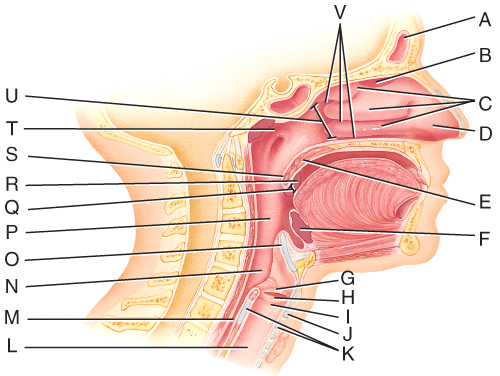
Where are the nasal conchae?
- a) A
- b) C
- c) T
- d) U
- e) V
b
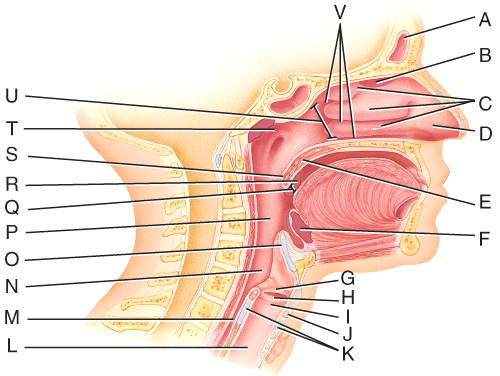
Which tonsils are found in the oropharynx?
- a) V
- b) R
- c) S
- d) Q
- e) U
b
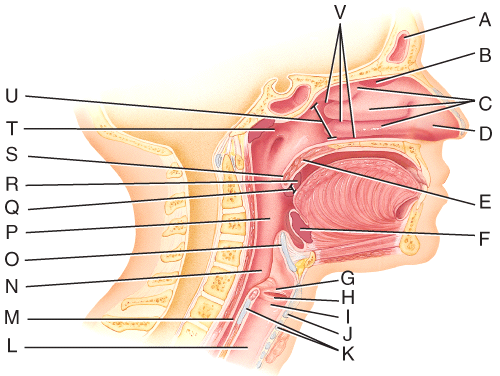
What structure is also referred to as the Adam’s Apple?
- a) G
- b) H
- c) I
- d) J
- e) K
d

Where is the larynx?
- a) I
- b) M
- c) L
- d) N
- e) O
a

Where is the uvula?
- a) E
- b) F
- c) Q
- d) S
- e) U
d
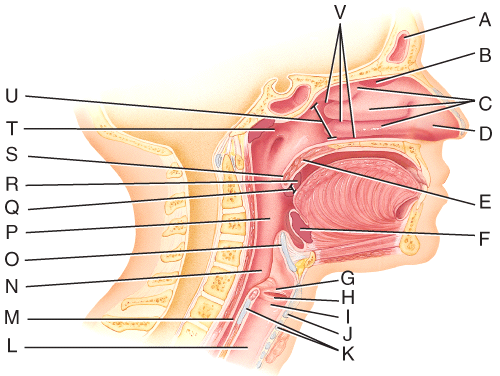
Where are the palatine tonsils?
- a) E
- b) F
- c) R
- d) U
- e) None of these choices
c
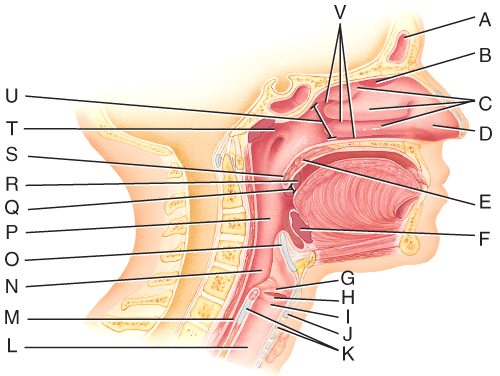
Where is the soft palate?
- a) C
- b) E
- c) G
- d) Q
- e) S
b

Where is the epiglottis?
- a) O
- b) R
- c) S
- d) F
- e) Q
a
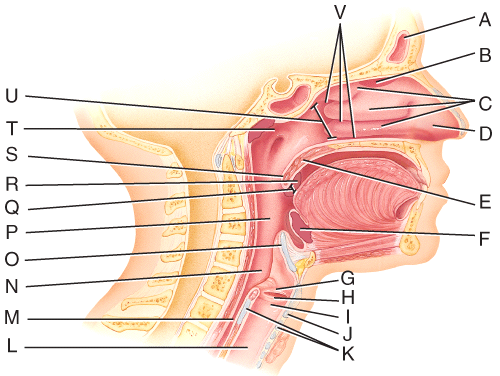
Where are the olfactory receptors found?
- a) A
- b) B
- c) C
- d) D
- e) U
b
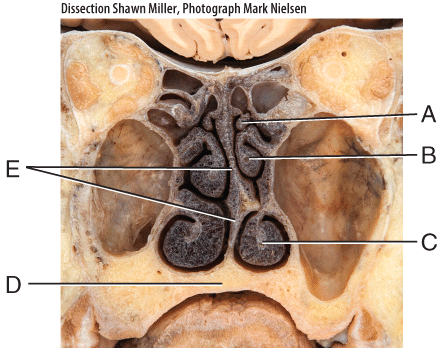
Where is the middle nasal concha?
- a) A
- b) B
- c) C
- d) D
- e) E
b
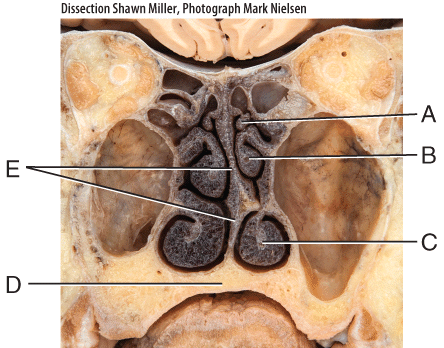
Where is the inferior nasal concha?
- a) A
- b) B
- c) C
- d) D
- e) E
c
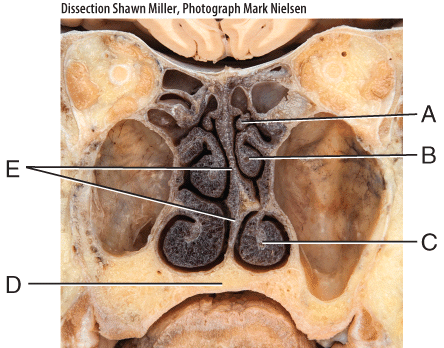
What is E pointing to?
- a) Soft palate
- b) Ethmoid bone
- c) Hard palate
- d) Nasal septum
- e) Air cells
d

What is line D pointing to?
- a) Thyrohyoid membrane
- b) Corniculate cartilage
- c) Cricothyroid ligament
- d) Cricoid cartilage
- e) Tracheal cartilage
b
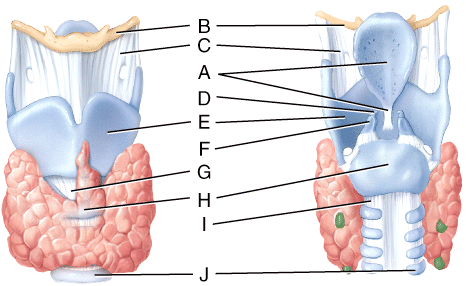
Where is the cricoid cartilage?
- a) D
- b) E
- c) F
- d) G
- e) H
e
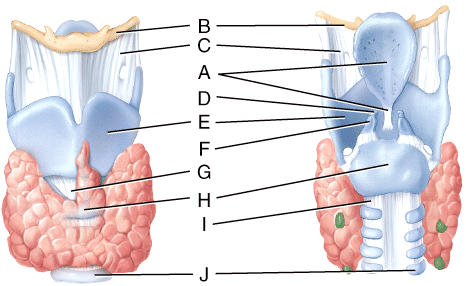
Where is the tracheal cartilage?
- a) J
- b) I
- c) H
- d) G
- e) F
a

What is line A pointing to?
- a) Hyoid bone
- b) Trachea
- c) Adams Apple
- d) Thyroid
- e) Epiglottis
e
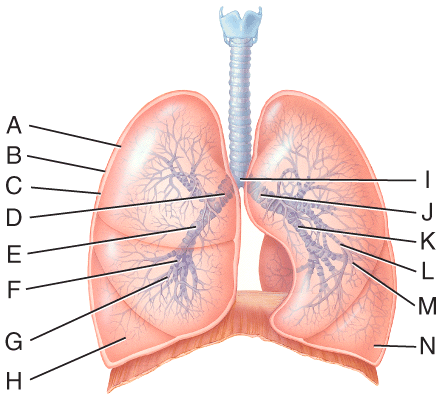
What is line J pointing to?
- a) Right secondary bronchus
- b) Left secondary bronchus
- c) Right primary bronchus
- d) Left primary bronchus
- e) Carina
d
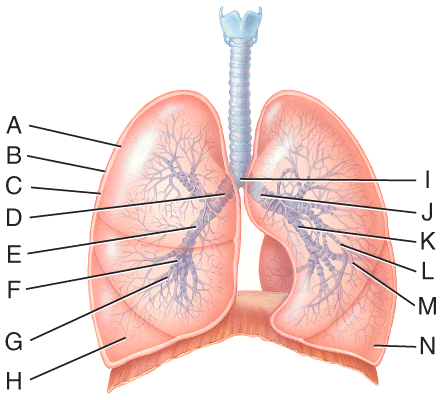
Where is the right bronchiole?
- a) F
- b) G
- c) H
- d) L
- e) M
b
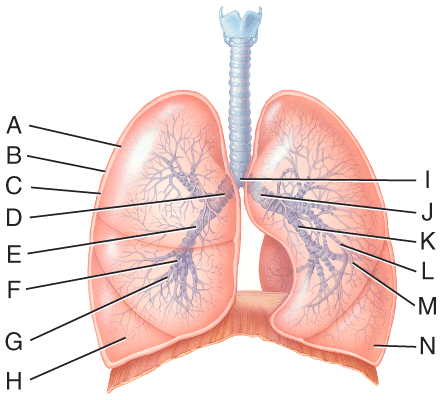
What lines are pointing to tertiary bronchi?
- a) E and K
- b) D and J
- c) F and L
- d) H and M
- e) A and B
c

What is line B pointing to?
- a) Carina
- b) Visceral pleura
- c) Parietal pleura
- d) Pleural cavity
- e) Diaphragm
c
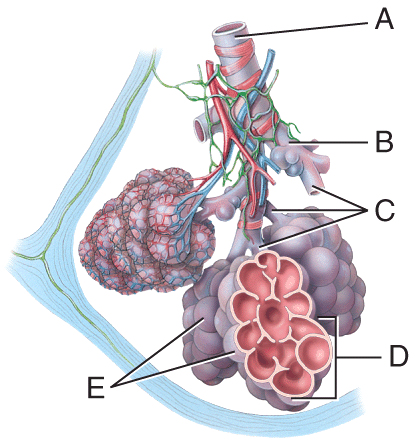
Which letter represents the primary gas exchange structure?
- a) A
- b) B
- c) C
- d) E
d

What is line C pointing to?
- a) Terminal bronchiole
- b) Respiratory bronchiole
- c) Alveolar ducts
- d) Alveolar sac
- e) Alveoli
c
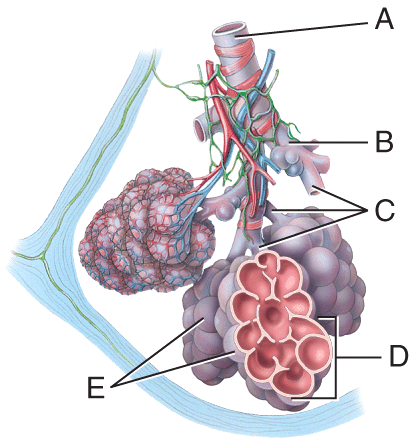
Where is the terminal bronchiole?
- a) A
- b) B
- c) C
- d) D
- e) E
a
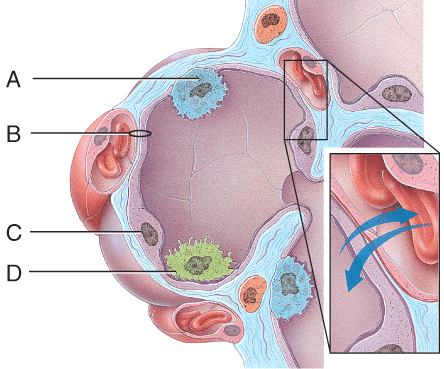
Which structure provides disease resistance within the lungs?
- a) A
- b) B
- c) C
- d) D
- e) None of these choices
d

Which cells are the main sites of gas exchange?
- a) A
- b) B
- c) C
- d) D
- e) All of these choices
c
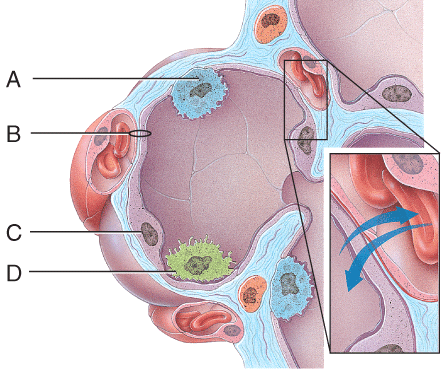
Which cell secretes surfactant?
- a) A
- b) B
- c) C
- d) D
- e) None of these choices
a
Normal quiet breathing is controlled by the
a) Pontine respiratory group
b) Medullary respiratory center dorsal respiratory group
c) Medullary respiratory center ventral respiratory group
d) Medullary respiratory center dorsal respiratory group and medullary respiratory center ventral respiratory group
e) all of these
e

What area in the figure is the sum of the tidal volume and the inspiratory reserve volume?
- a) A
- b) B
- c) G
- d) E
- e) H
d
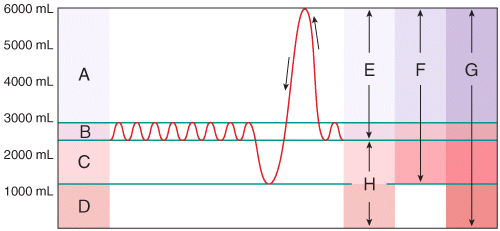
What area in the figure is the sum of the tidal volume and the inspiratory reserve volume and expiratory reserve volume?
- a) H
- b) B
- c) G
- d) E
- e) F
e
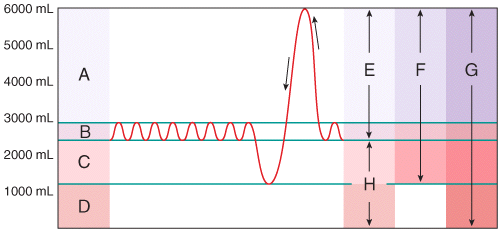
What area in the figure is the sum of the vital capacity and residual volume?
- a) B
- b) A
- c) G
- d) D
- e) F
c
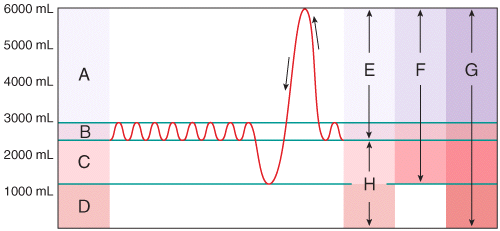
What area in the figure is the sum of the residual volume and the expiratory reserve volume?
- a) H
- b) A
- c) G
- d) E
- e) F
a
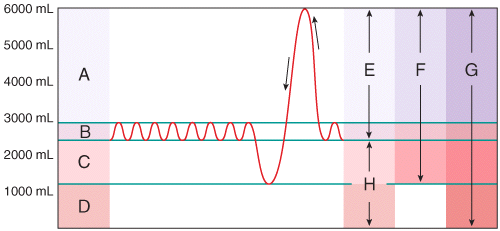
What area in the figure represents a very deep inhalation, much greater than the tidal volume?
- a) B
- b) A
- c) G
- d) E
- e) F
b

What area in the figure represents the volume of a normal breath?
- a) B
- b) A
- c) G
- d) E
- e) F
a
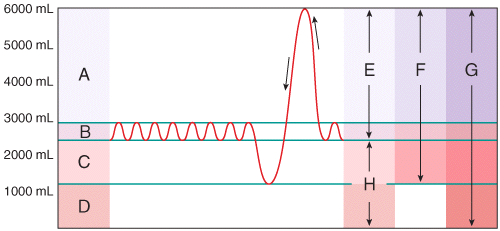
What area in the figure represents the volume of air remaining in the lungs after a deep exhalation?
- a) C
- b) H
- c) D
- d) B
- e) G
c
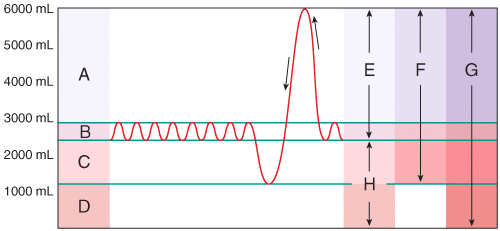
What area in the figure represents a very deep exhalation, much greater than the tidal volume?
- a) C
- b) H
- c) D
- d) B
- e) G
a
Which of the following is a forced exhalation against the closed rima glottidis as may occur during periods of straining while defecating?
- a) sobbing
- b) coughing
- c) crying
- d) hiccupping
- e) Valsalva maneuver
e
Which of the following is a spasmodic contraction of the diaphragm followed by spasmodic closure of the rima glottidis, which produces a sharp sound on inhalation?
- a) sneezing
- b) coughing
- c) laughing
- d) hiccupping
- e) Valsalva maneuver
d
Which of the following is an inhalation followed by many short convulsive exhalations during which the rima glottidis remains open and the vocal folds vibrate, accompanied by characteristic facial expressions?
a) sneezing
b) yawning
c) hiccupping
d) laughing
e) Valsalva maneuver
d
Which of the following is an inhalation followed by many short convulsive exhalations during which the rima glottidis remains open and the vocal folds vibrate, accompanied by characteristic facial expressions?
a) sneezing
b) yawning
c) hiccupping
d) crying
e) Valsalva maneuver
d
Which of the following is a series of convulsive inhalations followed by a single prolonged exhalation where the rima glottidis closes earlier than normal after each inhalation so only a little air enters the lung with each inhalation?
a) sobbing
b) sneezing
c) coughing
d) hiccupping
e) Valsalva maneuver
a
Which of the following is a deep inhalation through a widely opened mouth producing an exaggerated depression of the mandible, the precise cause of which is unknown?
a) sobbing
b) yawning
c) coughing
d) laughing
e) hiccupping
b
Which of the following is a long drawn and deep inhalation immediately followed by a shorter but forceful exhalation?
- a) sobbing
- b) yawning
- c) sighing
- d) hiccupping
- e) Valsalva maneuver
c
Which of the following is a spasmodic contraction of the muscles of exhalation that forcefully expels air through the nose and mouth?
- a) sobbing
- b) sneezing
- c) coughing
- d) sighing
- e) Valsalva maneuver
b
Which of the following is a long drawn and deep inhalation followed by a complete closure of the rima glottidis, which results in a strong exhalation, pushing the rima glottidis open and sending a blast of air through the upper respiratory passages?
a) crying
b) sneezing
c) coughing
d) sighing
e) Valsalva maneuver
c
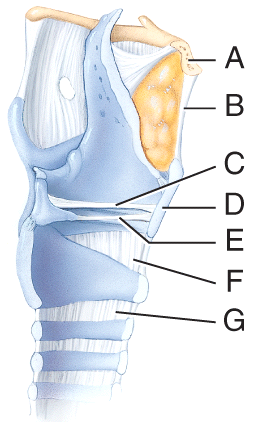
Which structure in the figure is the hyoid bone?
- a) A
- b) B
- c) D
- d) F
- e) G
a
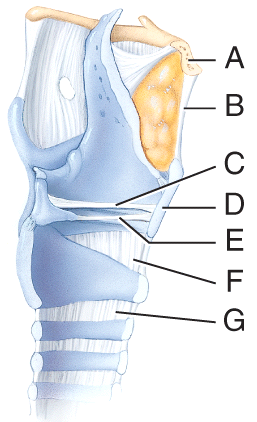
Which structure in the figure is the ventricular fold?
- a) F
- b) D
- c) C
- d) E
- e) G
c
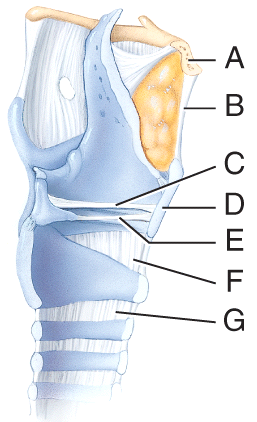
Which structure in the figure is the vocal fold?
- a) F
- b) D
- c) C
- d) E
- e) G
d
Where is the rhythmicity center for respiration?
a) in the medulla
b) in the pons
c) in the cerebrum
d) in the hypothalamus
e) in the cerebellum
a
With which body system does the respiratory system work to regulate the pH of body fluids?
- a) muscular
- b) digestive
- c) nervous
- d) endocrine
- e) urinary
e